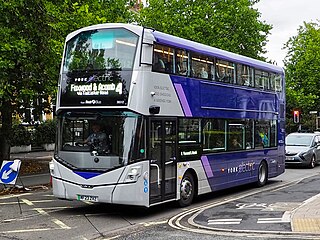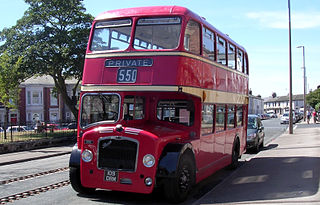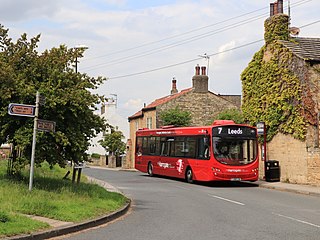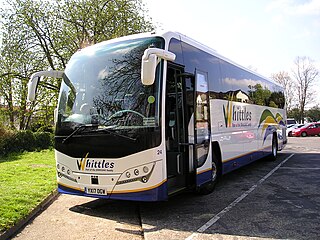
Transdev Blazefield is a bus group, which operates local and regional bus services across Greater Manchester, Lancashire, North Yorkshire and West Yorkshire, England. Formed in August 1991, the group has been a subsidiary of French-based operator Transdev since January 2006.

Metro is the passenger information brand used by the West Yorkshire Combined Authority in England. It was formed on 1 April 1974 as the West Yorkshire Passenger Transport Executive (WYPTE), at the same time as the metropolitan county of West Yorkshire. The Metro brand has been used from the outset and, since the formal abolition of the WYPTE on 1 April 2014, it has remained the brand name of public transport in the region, overseen by the West Yorkshire Combined Authority, which is also responsible for the delivery of transport policies.

The National Bus Company (NBC) was a nationalised bus company that operated in England and Wales between 1969 and 1988. NBC did not run buses itself, but was the owner of a number of regional subsidiary bus operating companies.

First York operates local bus services, with a network centring around the cathedral city of York, North Yorkshire, England. It is a subsidiary of FirstGroup, which operates bus, rail and tram services across the United Kingdom and Ireland.

The Burnley Bus Company operates both local and regional bus services in Greater Manchester and Lancashire, England. It is a subsidiary of Transdev Blazefield, which operates bus services across Greater Manchester, Lancashire, North Yorkshire and West Yorkshire.

The Bristol Lodekka was a half-cab low-height step-free double-decker bus built by Bristol Commercial Vehicles in England. It was the first production bus design to have no step up from the passenger entrance throughout the lower deck; although Gilford and Leyland Motors had developed low floor city buses in the 1930s, these did not enter production.

Yorkshire Coastliner is a bus company that operates both local and regional bus services in North Yorkshire and West Yorkshire, England. It is a subsidiary of Transdev Blazefield.

London Country Bus Services was a bus company that operated in South East England from 1970 until 1986, when it was split up and later sold as part of the bus deregulation programme.

The Keighley Bus Company operates both local and regional bus services in West Yorkshire, England. It is a subsidiary of Transdev Blazefield.

The Harrogate Bus Company operates both local and regional bus services in North Yorkshire and West Yorkshire, England. It is a subsidiary of Transdev Blazefield.

The Leyland Lynx was a stepped-entrance single-decker bus manufactured by Leyland in Workington, England between 1986 and 1992. After the takeover by Volvo, it was succeeded by the Volvo B10B.

United Automobile Services was a bus company, which operated local and regional bus services in County Durham, Cumbria, Northumberland, North Yorkshire and Tyne & Wear, England. It provided bus services across a wide geographical area, stretching from the border town of Berwick-upon-Tweed in the north, Filey in the south, and Carlisle in the west.

The Daimler Fleetline is a rear-engined double-decker bus chassis which was built between 1960 and 1983.

Red & White Services was a bus company operating in south east Wales and Gloucestershire, England between 1929 and 1978.

The 36 is a bus service operated by The Harrogate Bus Company, which links Leeds, Harewood and Harrogate with Ripley and Ripon. It is operated by a fleet of high-specification Wright Gemini 3 bodied Volvo B5TL double-deck vehicles, branded in a red and black livery.

The Bristol RE was a rear-engined single-decker bus or single-decker coach chassis built by Bristol Commercial Vehicles from 1962 until 1982. It is often considered the most successful of the first generation of rear-engined single-decker buses.

London Country North East was a bus operator in South East England and London. It was formed from the split of London Country Bus Services in 1986 and operated a fleet of around 350 buses from six garages, with its headquarters located in Hatfield.

Whittles is a coach tour operator based in Kidderminster, England.
Grahams of Paisley was an independent bus operator in called Andrew Graham. Paisley, Scotland. Based at its Hawkhead Road depot, it provided local bus services around the town of Paisley. It also provided the Linwood Clipper express coach service from Linwood to Glasgow in the 1970s and 1980s.





















